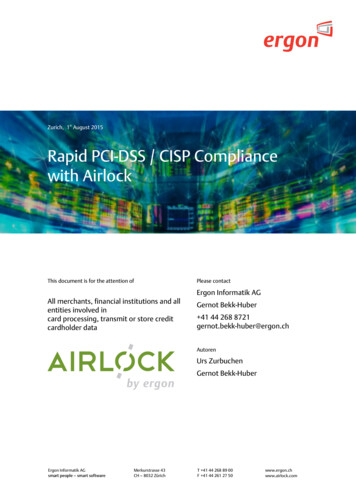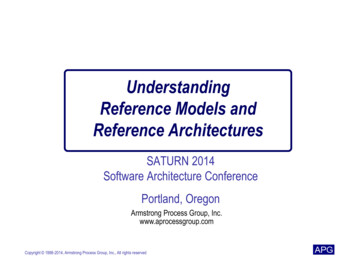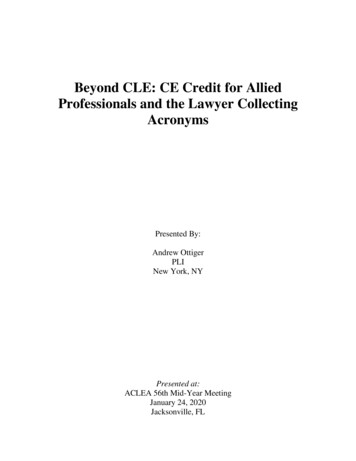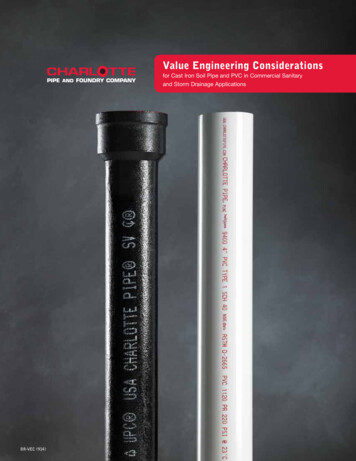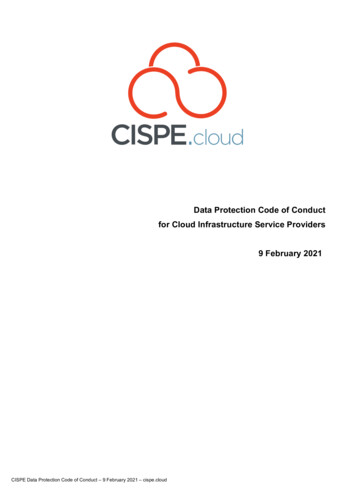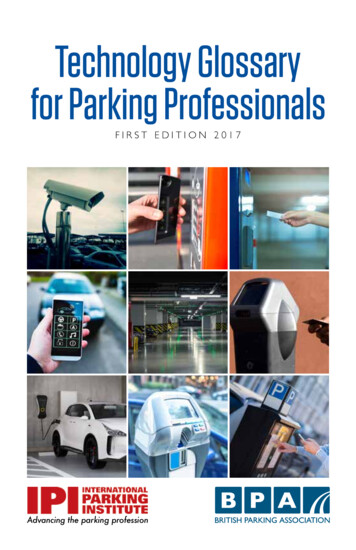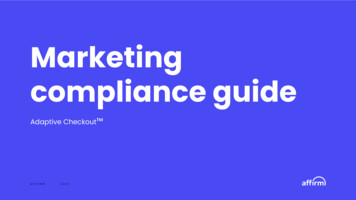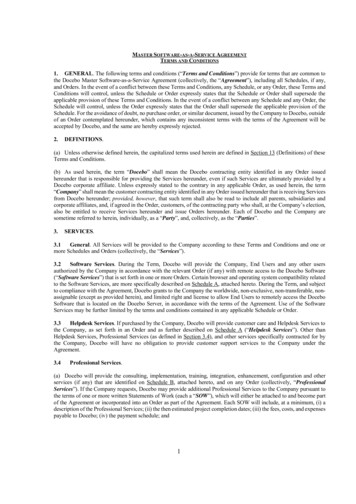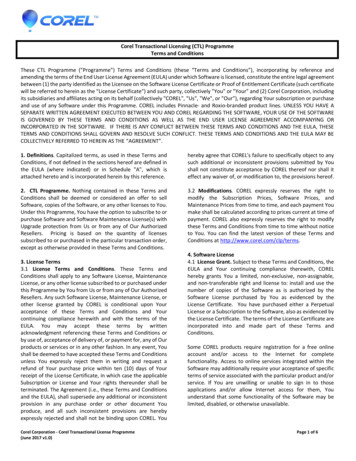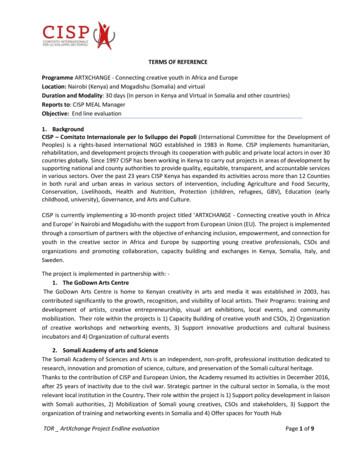
Transcription
TERMS OF REFERENCEProgramme ARTXCHANGE - Connecting creative youth in Africa and EuropeLocation: Nairobi (Kenya) and Mogadishu (Somalia) and virtualDuration and Modality: 30 days (In person in Kenya and Virtual in Somalia and other countries)Reports to: CISP MEAL ManagerObjective: End line evaluation1. BackgroundCISP – Comitato Internazionale per lo Sviluppo dei Popoli (International Committee for the Development ofPeoples) is a rights-based international NGO established in 1983 in Rome. CISP implements humanitarian,rehabilitation, and development projects through its cooperation with public and private local actors in over 30countries globally. Since 1997 CISP has been working in Kenya to carry out projects in areas of development bysupporting national and county authorities to provide quality, equitable, transparent, and accountable servicesin various sectors. Over the past 23 years CISP Kenya has expanded its activities across more than 12 Countiesin both rural and urban areas in various sectors of intervention, including Agriculture and Food Security,Conservation, Livelihoods, Health and Nutrition, Protection (children, refugees, GBV), Education (earlychildhood, university), Governance, and Arts and Culture.CISP is currently implementing a 30-month project titled ‘ARTXCHANGE - Connecting creative youth in Africaand Europe’ in Nairobi and Mogadishu with the support from European Union (EU). The project is implementedthrough a consortium of partners with the objective of enhancing inclusion, empowerment, and connection foryouth in the creative sector in Africa and Europe by supporting young creative professionals, CSOs andorganizations and promoting collaboration, capacity building and exchanges in Kenya, Somalia, Italy, andSweden.The project is implemented in partnership with: 1. The GoDown Arts CentreThe GoDown Arts Centre is home to Kenyan creativity in arts and media it was established in 2003, hascontributed significantly to the growth, recognition, and visibility of local artists. Their Programs: training anddevelopment of artists, creative entrepreneurship, visual art exhibitions, local events, and communitymobilization. Their role within the projects is 1) Capacity Building of creative youth and CSOs, 2) Organizationof creative workshops and networking events, 3) Support innovative productions and cultural businessincubators and 4) Organization of cultural events2. Somali Academy of arts and ScienceThe Somali Academy of Sciences and Arts is an independent, non-profit, professional institution dedicated toresearch, innovation and promotion of science, culture, and preservation of the Somali cultural heritage.Thanks to the contribution of CISP and European Union, the Academy resumed its activities in December 2016,after 25 years of inactivity due to the civil war. Strategic partner in the cultural sector in Somalia, is the mostrelevant local institution in the Country. Their role within the project is 1) Support policy development in liaisonwith Somali authorities, 2) Mobilization of Somali young creatives, CSOs and stakeholders, 3) Support theorganization of training and networking events in Somalia and 4) Offer spaces for Youth HubTOR ArtXchange Project Endline evaluationPage 1 of 9
3. NatverkstanNätverkstan Kultur is a Cultural and Civil Society Organization based in Sweden that provides services andprojects within the independent cultural and civil society field. The main areas of focus: education and training,accounting services, Media lab, international exchange, Art and entrepreneurship, cultural projectmanagement, cultural economics and policy, leadership within cultural organizations. Their role within theproject is - 1) Capacity building of creative youth and CSOs in Sweden and Kenya, 2) Creative and culturalentrepreneurship and management trainings and 3) Support in the mobilization of cultural organizations, artinstitutions, authorities, and private enterprises for exchanges4. CoopcultureThis is a Cooperative operating in the heritage and cultural activities sector in Italy. It Offers answers andsolutions from the perspective of integration between cultural heritage, culture, tourism, and local economy.Special attention to local communities in all of their aspects: families, young people, children, the elderly andimmigrant communities. Their role in the project is - 1) Strategic support and liaison with Italian authorities andstakeholders, 2) Trainings on cooperative model, capacity building exchanges and networking in Kenya and 3)Organization of intercultural international events in EuropeCISP as the project lead seeks the services of a professional consultant to provide support in externalendline project evaluation of the ArtXchange project.Project/Department Intervention LogicOverall ProjectObjectiveTo enhance inclusion, empowerment, and connection for youth in the creative sector inAfrica and Europe.Specific ProjectObjectivesTo support young creative professionals, CSOs and organizations, by promotingcollaboration, capacity building and exchanges in Kenya, Somalia, Italy, and Sweden.Relevant ProjectResult Areas Increased access to capacity and skills development opportunities for youth andyouth-led organizations in the creative sector in East Africa.Increased access for young creatives in East Africa to professional networks/platforms, job, and market opportunities in the creative sector locally andinternationally.Promoted intercultural dialogue and inclusion through co-production ofinnovative and impactful creative events and projects by and for youth in EastAfrica and Europe.2. Objective of the AssignmentCISP is seeking a consultant/s to verify the relevance of the project with respect to the problems faced by thetarget group, the coherence of the implemented action to the set objectives and results, the effectivenessand efficiency of the action, the impact and sustainability of the project in the long term. The measurementof the impact will be based on the objective and result indicators set and agreed with the donor.Furthermore, the evaluations will aim to:TOR ArtXchange Project Endline evaluationPage 2 of 9
a)b)c)d)e)Assess the Relevance, Coherence, Effectiveness, Efficiency, Impact and Sustainability of the project.Ensure sound administrative and financial management.Evaluate the outcomes and impact achieved (intended or unintended) by the projectProvide information about how the project activities can be better aligned with policies and guidelines.Identify best practices and lessons learnt that came out of the project and propose practices that can be scaled up in future programming.3. Scope of Services, Deliverables & TimelinesThe consultancy will deliver the services for 30 days in the month of September 2022 (at the end of the project). The main expected outcomes fromthis assignment which will be physical evaluation for Nairobi and virtually in Somalia and Europe are detailed in the tables below:Scope of ServicesDeliverablesTimelineDesign, plan and conduct the project final evaluation at the end of the project. Theevaluation strategy should correspond to the project's operational context, learning andoperational needs. The evaluations should be guided by well-known approaches andtheories, such as the Capability Approach, with the aims of:a) Measuring the performance of the project according to DAC criteria (Relevance,Coherence, Effectiveness, Efficiency, Impact and Sustainability) andb) Identifying best and promising practices for replication and disseminationThe key questions (following DAC criteria) that should be answered by the evaluationsinclude the following, divided into categories of analysis:Evaluation CriteriaRelevanceCoherenceMandatory Evaluation Questions1. To what extent was the project strategy and activitiesimplemented?2. To what extent do achieved results (project goal,outcomes, and outputs) continue to be relevant to theneeds of the targeted beneficiaries?1. To what extend is the project compatible with otherinterventions in the sector?TOR ArtXchange Project Endline evaluation1. An inception report detailingthe approach andmethodology to be used andsample size calculations, adetailed execution plan anddata-collection tools.2. Collected data (raw) afteranalysis submitted to CISPalongside the final evaluationreport (in soft and hardcopies).3. A preliminary report of findingsgathered during the endlineevaluation for validationworkshops.4. An updated project logicalframework based on thefindings.Page 3 of 930 days - to becompleted by30th September2022
EffectivenessEfficiencyImpactSustainability2. To what extend is the project consistent withintervention by other actors in the sector.1. To what extent were the intended project goal,outcomes and outputs achieved and how?2. To what extent did the project reach the targetedbeneficiaries at the project goal and outcome levels?How many beneficiaries have been reached?3. To what extent has this project generated positive (ornegative) changes in the lives of targeted (anduntargeted) beneficiaries. Please describe thosechanges.4. What internal and external factors contributed to theachievement and/or failure of the intended projectgoal, outcomes, and outputs? How?1. How efficiently and timely has this project beenimplemented and managed in accordance with theProject Document? Specifically have resources beenused well and strategies to implementation beenappropriate.2. How could the efficiency of the project be improvedwithout compromising outputs?3. How adequate were the reporting and monitoringsystems of the project?1. What are the unintended consequences (positive andnegative) resulted from the project?5. A final full-length technicalevaluation report (in soft andhard copies) of the endlineevaluation intended for CISP,the consortium partners andthe donor.6. A summarized version of theendline evaluation report in avisually pleasing, graphicallydesigned, and digestibleformat intended for externaldissemination1. How are the achieved results, especially the positivechanges/ models generated by the project to besustained after this project ends?TOR ArtXchange Project Endline evaluationPage 4 of 9
Knowledge Generation2. How strong are the relationships with government,other agencies, and Civil Society Organization (CSOs)that can be improved (in terms of partnerships,collaboration, networking, and coordination)?1. What are the key lessons learned that can be sharedwith other practitioners and stakeholders in the artsand creative sector?2. Are there any promising practices? If yes, what are theyand how can these promising practices be replicated inother projects?The evaluations should also include recommendations for learning purposes, as well as flagging and analysis of issues where management andstrategic attention is required in future programming.4. Consultancy timeframeThe consultancy shall run for 30 days, with preference made for a service provider that can optimize the timing to reduce the total number of days byfinding synergies between the partners in Nairobi and Mogadishu.Before commencing the tasks, the Consultant should develop and share plans with CISP (project lead), which will coordinate the feedback of partnersand key stakeholders in Nairobi, Mogadishu, and Europe for any comment/inputs in order to validate the plan.5. Consultancy delivery methodologyIn addition to attending briefing meetings, the consultant will develop an evaluation methodology; the below methodologies will be utilized but not limited to.i.Desk reviewii.Sites visits and Observationiii.Semi structured interviews and focus group discussion with beneficiariesiv.Staff, project partner and other relevant stakeholders Interviewv.The consultant is responsible for data collection, analysis and interpretation of the data and writing of the final reportTOR ArtXchange Project Endline evaluationPage 5 of 9
The Service Provider will make its own logistic arrangements and cover all relevant expenses associated with the service, including data collection in the fieldand training, and meeting logistic expenses. CISP, and its partners will assist in the provision of requisite background information and, where possible, will linkup the Service Provider with beneficiaries. CISP and partners will facilitate contact with key stakeholders.6. Contract Award CriteriaThe contract will be awarded based on the following evaluation process in chronological order:a) Preliminary Evaluation: Applications will be assessed against the application instructions (see below, “preliminary evaluation table below"). Noncompliance or lack of meeting any of the minimum requirements will result in automatic disqualification of the application. Applicants that complywith all the minimum requirements will pass on to the Technical Evaluation stage.b) Technical Evaluation: Applications that pass the preliminary evaluation will be assessed only on their Technical Proposal. Only applications that obtaina score of over 30 out of 50 or higher on the Technical Evaluation will proceed to the Financial Evaluation.c) Financial Evaluation: Applications that proceed to the Financial Evaluation stage will be assessed on their Financial Proposal against the applicationinstructions. Non-compliance or lack of meeting any of the minimum requirements for the Financial Proposal will result in automatic disqualificationof the application. The final selection will be based on the principle of “best value for money” i.e., achieving desired outcome at lowest possible fee.TOR ArtXchange Project Endline evaluationPage 6 of 9
1) Preliminary EvaluationYes/NoCommentsName/firm has been verified on EU website www.sanctionsmap.eu andcertified it is not in the sanctions ListCover page is submittedA detailed technical proposalA financial proposalCV of the applicant (s) including 2 refereesTwo Letters of recommendations from Companies/Organizationsserved in the past three years are included in the applicationAt least two samples of previous work are included in the applicationTax Compliance Certificate is included in the applicationAt least 5 years of experience in conducting evaluations2) Technical nce to ToR’s specifications: a clear understanding ofrequired deliverables.Technical experience in Project’s evaluation, MEAL tools, etc.Excellent report writingCompliance with intended completion date and demonstrated optimizationof the workplanExperience in youth empowerment preferably in Kenya and somalia ormore countriesExcellent understanding of qualitative & quantitative data analytical skillsUnderstanding of art for social change methodologies3) Financial EvaluationThe Financial Proposals is inclusive of all costs required to render the services andachieve the deliverables of this TOR.The currency used for the Financial Proposal is in Kenya Shillings and shouldinclude all relevant taxes.7. PaymentParties will agree on a payment schedule with the successful candidates based on the achievement of setmilestones. The applicants are encouraged to propose the payment schedules in their financial proposal. Pleasenote this will not affect the selection.TOR ArtXchange Project Endline evaluationPage 7 of 9
8. Service Provider ProfileThe profile of the Service Provider must meet the following minimum requirements:o Minimum of a bachelor’s degree in Arts and culture, economics, social sciences, statistics, education, orany other relevant field.o At least 5 years’ experience of conducting program evaluations / impact evaluations with a focus on bothqualitative and quantitative approaches.o Excellent command of written and spoken English.o Preferrable with good understanding of at least one local language either Swahili or Somali. (Having bothis an asset)o Good understanding of youths programming, arts, and culture in the region particularly Kenya andSomalia context (particularly creativity among youth)o Well versed in the use of appropriate analytical software as will be appropriate for a mixed methodsstudy.o Strong analytical and reporting skills9. MODE OF APPLICATIONApplications should be submitted on or before 17:00 EAT (20th July 2022) via email as follows:TO kenya@cisp-ngo.orgCC andrew.chemoiywo@cisp-ngo.orgAll applications must include all of the following:1. Cover letter (maximum 1 page)2. Technical Proposal – technical proposal must include the following: a. Profile of the Service provider with particular emphasis on previous experience in thiskind of workb. Description of the proposed approach with clear justifications, understanding of the TORand the tasks to be accomplished, highlighting the bidder experience and qualifiedpersonnel to perform all aspects of the assignment and deliver the services.c. Description of how you intend to manage the remote evaluation in Somalia and Europed. Proposed workplan for the assignments.3. Financial proposal: A quote that should be inclusive of all costs required to render the services. Thecurrency used for the Financial Proposal should be in Kenya Shillings should including all relevant taxes.Note that: The above attachments are requirements including the other mandatory documents for preliminaryevaluation.At the discretion of CISP, applicants may be invited to supply additional information on the contents oftheir proposal during the Evaluation and award process; this will be communicated via email shouldneed arise.TOR ArtXchange Project Endline evaluationPage 8 of 9
CISP is strongly committed to ending child abuse, all forms of sexual exploitation and abuse, and to buildinga work environment that is safe and welcoming for all, where sexual harassment does not take place. Thedesired candidate for any position should share and support this commitment in all aspects of theirpersonal and professional behavior. Any history implicating that the applicant has a history of child abuse,sexual exploitation and abuse, or sexual harassment, is a reason for excluding him or her from employmentwith CISP.TOR ArtXchange Project Endline evaluationPage 9 of 9
TOR _ ArtXchange Project Endline evaluation Page 1 of 9 TERMS OF REFERENCE Programme ARTXCHANGE - Connecting creative youth in Africa and Europe Location: Nairobi (Kenya) and Mogadishu (Somalia) and virtual Duration and Modality: 30 days (In person in Kenya and Virtual in Somalia and other countries) Reports to: CISP MEAL Manager Objective: End line evaluation
